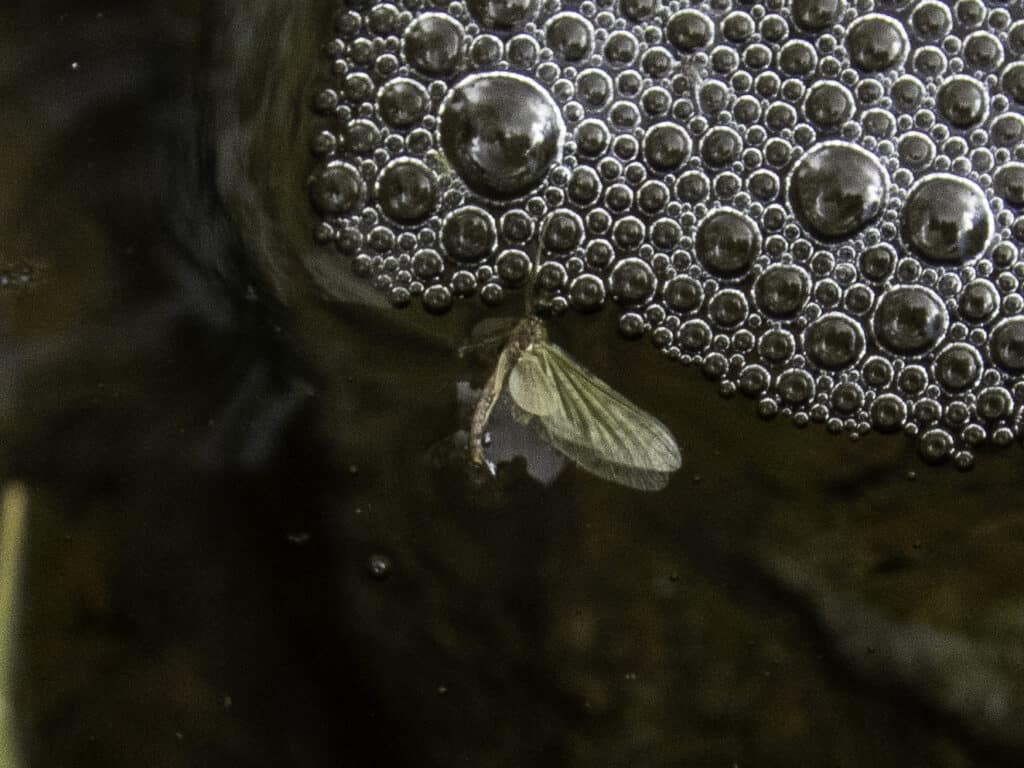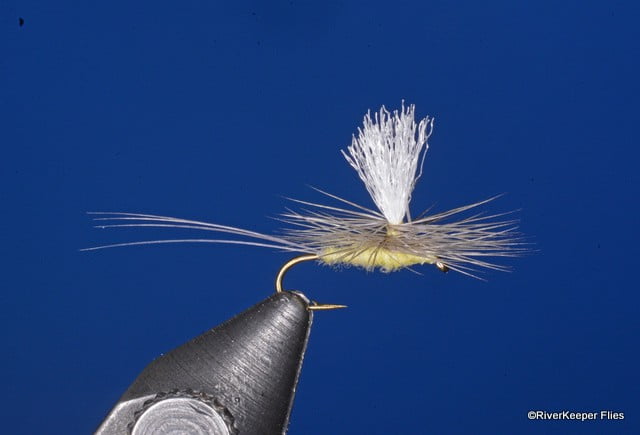It’s PMD time again! I always look forward to this hatch. It begins in late May and will continue through September. Many hatches are in full swing now on my local waters in Central Oregon. Besides PMDs, there are Salmonflies, Green Drakes, and Caddis. It’s a wonderful time of year!

PMDs, otherwise known as Pale Morning Duns, are an important hatch for fish and fly fishers. Generally, you’ll find these flies in sizes 16 -18. Normally, they will hatch in the afternoon between 1 and 3 pm on my local river.

Most of the time, PMDs have a pale yellow body and smokey gray (or dun color) wing. But their body colors vary and include shades of pale green, yellowish-tan, or a light reddish-brown. Look at the bug carefully. The underside of the insect is what the fish sees and the color is usually lighter than on top.
The image below is an example of the “light reddish-brown” mentioned above. I would characterize it as a “March Brown” color for the body.

A good way to see the colors of the real insect is to spend time looking for bugs in an eddy. Eddies capture the bugs and it’s a place I spend time to take a closer look. Here is an image from last week.

Notice how the insect is laying on its side?
Many times, one wing or both get caught on the water’s surface. This is an easy meal for a trout.

In fact, this profile is exactly why I created the RiverKeeper Soft Hackle Cripple. It imitates this profile very well.

Mayflies in general spend much of their life as a nymph, rummaging around the rocky stream bed. When it’s time to hatch, the nymphal shuck breaks open and an adult mayfly crawls out and becomes a dun. Hatching may occur underwater or in the surface film. The PMD breaks through the surface film and waits for both wings to dry as the fly floats downstream in the current. Now the mayfly flutters its wings and takes flight. Sometimes it lands on the water again, floats some more then flies away to nearby vegetation and wait to become sexually mature.
A good number of mayflies don’t make it out of the nymphal shuck. We call these cripples.
Here is a PMD found in a back-eddy that was stuck in its nymphal shuck.

Look closely and you’ll see the empty nymphal shuck stuck to the back of the natural. It was unable to fully climb out. It’s a perfect example of why I use a Sparkle Dun to imitate this activity.
Similar to breaking out of the nymphal shuck, the dun too sheds the skin as the thorax splits open and out crawls another insect with clear wings which is called a spinner. The body color of the Pale Morning Dun spinners range from tan to rust, hence the name “Rusty Spinner”.

Females fly into swarms of males to mate. Watch for birds flying above the river. That’s a tell-tale sign spinner activity is about to begin. After mating, the males drop into the water and are available to fish. You probably won’t see them, only the occasional sip of a trout and you’ll ask “I wonder what it took”? That’s the time to pull out a Rusty Spinner.
Another interesting fact is how to distinguish a female from a male.
Check out the eyes. Males have large, bright orange or rust colored eyes whereas females are pale. Look back at some of the images above and you’ll see the difference. Find a back eddy during a PMD hatch like I did and pick up a few real bugs. You’ll be amazed. At times, I think the fish key on them. Such a small detail…

Here are my favorite dry flies I use to imitate PMDs.
The only difference between the Sparkle Dun and Improved Sparkle Dun is the body is thread and includes a wing backing of Zelon to help me see the fly floating on the surface. All my size 18 flies are tied like this.
But don’t sell the original Sparkle Dun short. It is an amazing imitation.
Here is a fly I used last week.

And the top view.

Notice how half of the wing is missing? Keep that in mind when trying to create the perfect wing on your flies. At times, the fish don’t seem to care!
Other popular flies to imitate the various stages of a PMD include:
Check out the Mayfly Fly Patterns page for more flies to imitate the naturals.
Lastly, I’ve included a couple more posts from the Archives you might enjoy:
Enjoy…go fish, stay safe!
(John Kreft is a participant in the Amazon Services LLC Associates Program, an affiliate advertising program designed to provide a means for sites to earn advertising fees by advertising and linking to amazon.com.)


















John.. that’s a terrific post. Having those photos of the bugs to illustrate your text is awesome. Wish I had the patience to sit by the river and search out those photo opportunities.
Thanks for the Comment Ron.
When the fish aren’t rising, I have a little extra time to look around. I can’t tell you how many images go into recycle to get a few good ones!
John